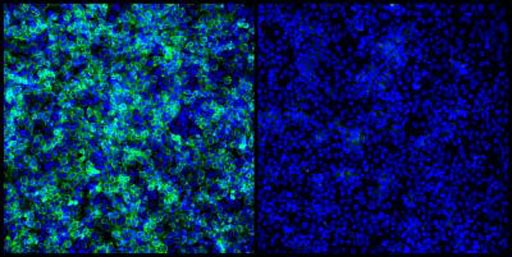Nanchangmycin Prevents Zika and Related Viruses from Infecting Cells
By LabMedica International staff writers
Posted on 31 Jan 2017
Several low molecular weight drugs have been identified that demonstrate promising effectiveness for blocking infection by Zika and other related viruses.Posted on 31 Jan 2017
Zika virus is an emerging arthropod-borne flavivirus for which there are no vaccines or specific drugs. In searching for drugs capable of blocking Zika, investigators at the University of Pennsylvania screened a library of 2,000 bioactive compounds for their ability to block Zika virus infection in three distinct cell types with two different strains of Zika virus.

Image: Human placental cell line Jeg-3 can be readily infected by a circulating strain of Zika virus (left panel) and completely protected by treatment with nanchangmycin (right panel). All cells are shown in blue while virally infected cells are stained in green (Photo courtesy of Dr. Sara Cherry, University of Pennsylvania).
The investigators reported in the January 17, 2017, online edition of the journal Cell Reports that use of a microscopy-based assay enabled them to validate 38 drugs that inhibited Zika virus infection, including FDA-approved nucleoside analogs. Cells expressing high levels of the attachment factor AXL (AXL receptor tyrosine kinase) were protected from infection with receptor tyrosine kinase inhibitors, while placental-derived cells that lacked AXL expression were insensitive to this inhibition.
The investigators identified the antibacterial agent nanchangmycin (manufactured by the bacterium Streptomyces nanchangensis) as a potent inhibitor of Zika virus entry across all cell types tested, including physiologically relevant primary cells. Nanchangmycin also was active against other medically relevant viruses, including West Nile, dengue, and chikungunya viruses that use a similar route of entry. Parainfluenza virus 5 (PIV5), which enters cells by a completely different route, was not blocked by this drug.
"Overall, the most important finding is that we identified nanchangmycin as a potent inhibitor of Zika virus entry across all cell types tested, including endothelial and placental cells, which are relevant to how Zika may enter the fetus," said senior author Dr. Sara Cherry, associate professor of microbiology at the University of Pennsylvania. "Nanchangmycin is a stepping stone to a new class of anti-virals, because it thwarts this essential mode of entry by viruses like Zika. Future studies will identify the target of this drug and current studies are testing the efficacy of nanchangmycin in animal models of Zika virus infection."













